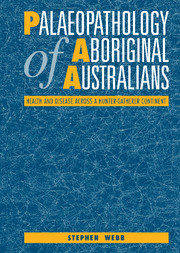Book contents
- Frontmatter
- Contents
- List of illustrations
- List of tables
- Acknowledgements
- 1 Introduction
- 2 Australian palaeopathology, survey methods, samples and ethnohistoric sources
- 3 Upper Pleistocene pathology of Sunda and Sahul: some possibilities
- 4 Pathology in late Pleistocene and early Holocene Australian hominids
- 5 Stress
- 6 Infectious disease
- 7 Osteoarthritis
- 8 Trauma
- 9 Neoplastic disease
- 10 Congenital malformations
- 11 Motupore: the palaeopathology of a prehistoric New Guinea island community
- 12 The old and the new: Australia's changing patterns of health
- References
- Index
11 - Motupore: the palaeopathology of a prehistoric New Guinea island community
Published online by Cambridge University Press: 21 May 2010
- Frontmatter
- Contents
- List of illustrations
- List of tables
- Acknowledgements
- 1 Introduction
- 2 Australian palaeopathology, survey methods, samples and ethnohistoric sources
- 3 Upper Pleistocene pathology of Sunda and Sahul: some possibilities
- 4 Pathology in late Pleistocene and early Holocene Australian hominids
- 5 Stress
- 6 Infectious disease
- 7 Osteoarthritis
- 8 Trauma
- 9 Neoplastic disease
- 10 Congenital malformations
- 11 Motupore: the palaeopathology of a prehistoric New Guinea island community
- 12 The old and the new: Australia's changing patterns of health
- References
- Index
Summary
Introduction
At the beginning of this book I spoke of the divergence in the palaeoepidemiological histories of Australia and Papua New Guinea following their separation by rising seas at the end of the last Ice Age. It is also interesting to see the stark differences that emerged in their respective epidemiologies by the intervention of what is a rather small shallow oceanic strait, rather than the pathological continuum that existed when they were part of the same continent. Prominent in my earlier remarks was the fact that we know almost nothing about the pre-contact history of human health in Papua New Guinea and, at this time, are not able to trace that history in quite the same way I have attempted for Australia. One of the main reasons for this is the difficulty of obtaining palaeopathological data from the region. I mentioned also that the major factors determining the particular health status of the inhabitants of Papua New Guinea have been the equatorial environment and the size and demographic organisation of its populace. It is because of these important contrasts between Australia and Papua New Guinea that I have included the following report. These data are vital in our story because they provide a unique opportunity to compare and contrast the Australian picture with our closest northern neighbour which, until about 7000 years ago, formed the northern end of our continent.
- Type
- Chapter
- Information
- Palaeopathology of Aboriginal AustraliansHealth and Disease across a Hunter-Gatherer Continent, pp. 256 - 271Publisher: Cambridge University PressPrint publication year: 1995



